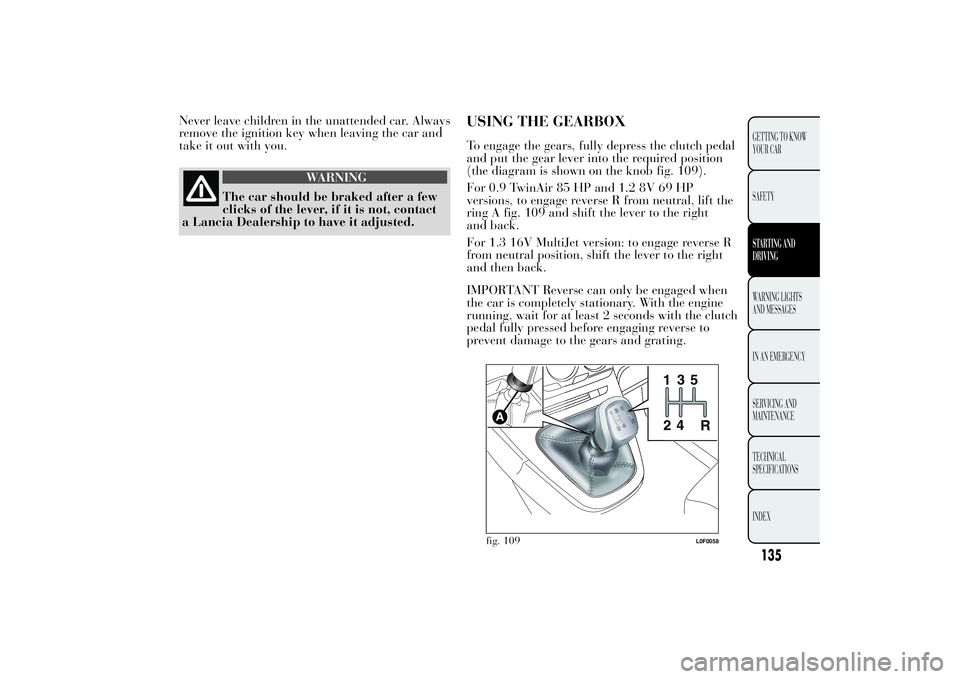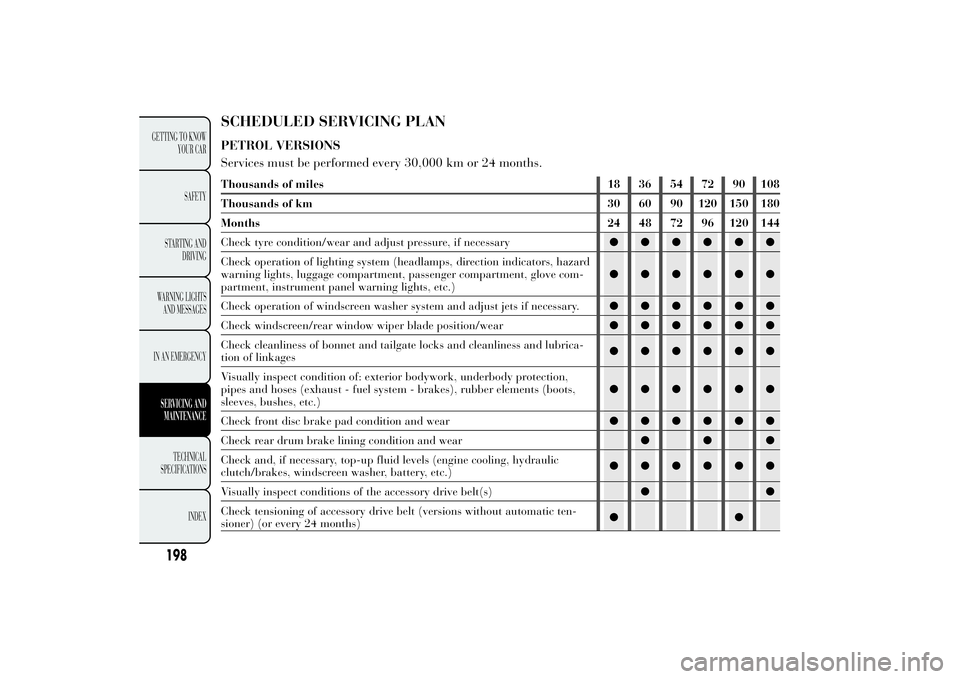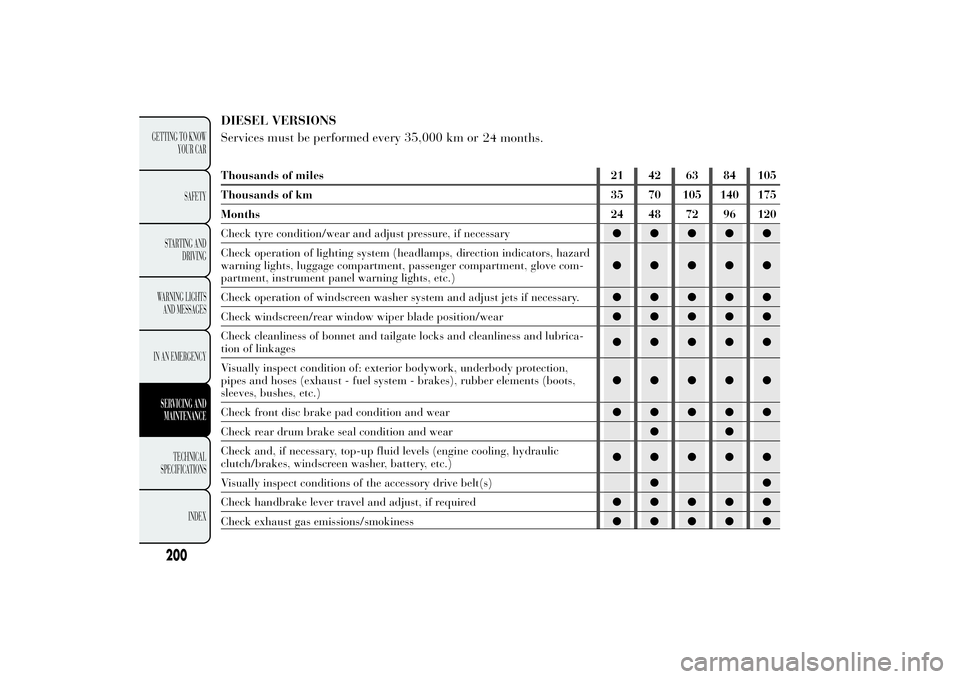clutch Lancia Ypsilon 2011 Owner handbook (in English)
[x] Cancel search | Manufacturer: LANCIA, Model Year: 2011, Model line: Ypsilon, Model: Lancia Ypsilon 2011Pages: 299, PDF Size: 13.35 MB
Page 137 of 299

Never leave children in the unattended car. Always
remove the ignition key when leaving the car and
take it out with you.
WARNING
The car should be braked after a few
clicks of the
lever, if it is not, contact
a Lancia Dealership to have it adjusted.
USING THE GEARBOXTo engage the gears, fully depress the clutch pedal
and put the gear lever into the required position
(the diagram is shown on the knob fig. 109).
For 0.9 TwinAir 85 HP and 1.2 8V 69 HP
versions, to engage reverse R from neutral, lift the
ring A fig. 109 and shift the lever to the right
and back.
For 1.3 16V MultiJet version: to engage reverse R
from neutral position, shift the lever to the right
and then back.
IMPORTANT Reverse can only be engaged when
the car is completely stationary. With the engine
running, wait for at least 2 seconds with the clutch
pedal fully pressed before engaging reverse to
prevent damage to the gears and grating.
fig. 109
L0F0058
135GETTING TO KNOW
YOUR CAR
SAFETYSTARTING AND
DRIVINGWARNING LIGHTS
AND
MESSAGES
IN AN
EMERGENCY
SERVICING AND
MAINTENANCE
TECHNICAL
SPECIFICATIONS
INDEX
Page 138 of 299

WARNING
Press the clutch pedal fully to change
gears correctly.
It is therefore
essential that there is nothing under the
pedals: make sure the mats are lying flat and
do not get in the way of the pedals.Do not drive with your hand resting on
the gear lever as the force exerted,
even if slight, could lead over time to
premature wear of the gearbox internal
components.
FUEL SAVINGSHere are some suggestions which may help you to
save fuel and lower the amount of harmful
emissions released into the atmosphere.
GENERAL CONSIDERATIONS
Car maintenance
Have checks and adjustments carried out in
accordance with the “Scheduled Servicing Plan”.
Tyres
Check the tyre pressure at least once every 4
weeks: if the pressure is too low, consumption
levels increase as resistance to rolling is higher.
Unnecessary loads
Do not travel with an overloaded boot. The weight
of the car and its arrangement greatly affect fuel
consumption and stability.
Roof rack/ski rack
Remove the roof rack or the ski rack from the roof
after use. These accessories lower aerodynamic
penetration and adversely affect consumption
levels. When transporting particularly large
objects, use a trailer if possible.
136
GETTING TO KNOW
YOUR CAR
SAFETY
STARTING AND
DRIVINGWARNING LIGHTS
AND
MESSAGES
IN AN
EMERGENCY
SERVICING AND
MAINTENANCE
TECHNICAL
SPECIFICATIONS
INDEX
Page 139 of 299

Electrical devices
Only use electrical devices for the time needed.
The heated rear window, additional headlights,
windscreen wipers and heater fan need a
considerable amount of energy, therefore
increasing fuel consumption (by up to 25% in the
urban cycle).
Climate control system
The use of the climate control system leads to
higher fuel consumption. If the temperature
outside permits, try to use ventilation only.
Devices for aerodynamic control
The use of non-certified devices for aerodynamic
control may adversely affect air drag and fuel
consumption.
DRIVING STYLE
Starting
Do not warm the engine with the car at a
standstill or at idle or high speed: under these
conditions the engine warms up much more
slowly, increasing consumption and emissions. It is
therefore advisable to move off immediately,
slowly, avoiding high speeds: in this way
the engine will warm up more quickly.Unnecessary actions
Avoid revving up when at traffic lights or before
stopping the engine. This and also double
declutching is absolutely pointless on modern cars
and also increases consumption and pollution.
Gear selection
Use a higher gear as soon as traffic and road
conditions allow. Using a low gear for faster
acceleration will increase consumption.
In the same way improper use of a high gear
increases consumption, emissions and engine wear.
Maximum speed
Fuel consumption considerably increases as speed
increases. Maintain a constant speed, avoiding
unnecessary braking and acceleration, which cost
in terms of both fuel and emissions.
Acceleration
Sudden acceleration has a very negative effect on
fuel consumption and emissions: accelerate
gradually.
137GETTING TO KNOW
YOUR CAR
SAFETYSTARTING AND
DRIVINGWARNING LIGHTS
AND
MESSAGES
IN AN
EMERGENCY
SERVICING AND
MAINTENANCE
TECHNICAL
SPECIFICATIONS
INDEX
Page 200 of 299

SCHEDULED SERVICING PLANPETROL VERSIONS
Services must be performed every 30,000 km or 24 months.Thousands of miles 18 36 54 72 90 108
Thousands of km 30 60 90 120 150 180
Months 24 48 72 96 120 144
Check tyre condition/wear and adjust pressure, if necessary●●●●●●
Check operation of lighting system (headlamps, direction indicators, hazard
warning lights, luggage compartment, passenger compartment, glove com-
partment, instrument panel warning lights, etc.)●●●●●●
Check operation of windscreen washer system and adjust jets if necessary.●●●●●●
Check windscreen/rear window wiper blade position/wear●●●●●●
Check cleanliness of bonnet and tailgate locks and cleanliness and lubrica-
tion of linkages●●●●●●
Visually inspect condition of: exterior bodywork, underbody protection,
pipes and hoses (exhaust - fuel system - brakes), rubber elements (boots,
sleeves, bushes, etc.)●●●●●●
Check front disc brake pad condition and wear●●●●●●
Check rear drum brake lining condition and wear●●●
Check and, if necessary, top-up fluid levels (engine cooling, hydraulic
clutch/brakes, windscreen washer, battery, etc.)●●●●●●
Visually inspect conditions of the accessory drive belt(s)●●
Check tensioning of accessory drive belt (versions without automatic ten-
sioner) (or every 24 months)●●
198
GETTING TO KNOW
YOUR CAR
SAFETY
STARTING AND
DRIVING
WARNING LIGHTS
AND MESSAGES
IN AN EMERGENCYSERVICING AND
MAINTENANCE
TECHNICAL
SPECIFICA
TIONS
INDEX
Page 202 of 299

DIESEL VERSIONS
Services must be performed every 35,000 km or
24 months.Thousands of miles 21 42 63 84 105
Thousands of km 35 70 105 140 175
Months 24 48 72 96 120
Check tyre condition/wear and adjust pressure, if necessary●●●●●
Check operation of lighting system (headlamps, direction indicators, hazard
warning lights, luggage compartment, passenger compartment, glove com-
partment, instrument panel warning lights, etc.)●●●●●
Check operation of windscreen washer system and adjust jets if necessary.●●●●●
Check windscreen/rear window wiper blade position/wear●●●●●
Check cleanliness of bonnet and tailgate locks and cleanliness and lubrica-
tion of linkages●●●●●
Visually inspect condition of: exterior bodywork, underbody protection,
pipes and hoses (exhaust - fuel system - brakes), rubber elements (boots,
sleeves, bushes, etc.)●●●●●
Check front disc brake pad condition and wear●●●●●
Check rear drum brake seal condition and wear●●
Check and, if necessary, top-up fluid levels (engine cooling, hydraulic
clutch/brakes, windscreen washer, battery, etc.)●●●●●
Visually inspect conditions of the accessory drive belt(s)●●
Check handbrake lever travel and adjust, if required●●●●●
Check exhaust gas emissions/smokiness●●●●●
200
GETTING TO KNOW
YOUR CAR
SAFETY
STARTING AND
DRIVING
WARNING LIGHTS
AND MESSAGES
IN AN EMERGENCYSERVICING AND
MAINTENANCE
TECHNICAL
SPECIFICA
TIONS
INDEX
Page 226 of 299

FUEL SUPPLYVersions Power supply
0.9 TwinAir 85 HPTimed sequential Multipoint electronic injection, with knock control and intake
valve variable actuation
1.2 8V 69 HPMultipoint sequential timed electronic injection, returnless system
Electronically controlled Common Rail MultiJet direct injection with turbo and
intercooler 1.3 16v MultiJet
WARNING
Modifications or repairs to the fuel supply system that are not carried out correctly or
do not take
the system's technical specifications into account can cause malfunctions
leading to the risk of fire.
TRANSMISSIONVersions Gearbox Clutch Drive
0.9 TwinAir 85 HP
Five forward gears and
reverse with synchromesh for
forward gear engagementSelf-adjusting pedal without
idle strokeFront 1.2 8V 69 HP
1.3 16v MultiJet
224
GETTING TO KNOW
YOUR CAR
SAFETY
STARTING AND
DRIVING
WARNING LIGHTS
AND MESSAGES
IN AN EMERGENCY
SERVICING AND
MAINTENANCE
TECHNICAL
SPECIFICA
TIONS
INDEX
Page 241 of 299

UseFluid and lubricant features for a
correct use of the carGenuine fluids and
lubricantsApplications
Lubricants for
motion trans-
missionSAE 75W grade synthetic lubricant.TUTELA
MISSION
Contractual Technical
Reference No.
F002.F10Manual gearbox and dif-
ferential
Molybdenum disulphide grease, for use at
high temperatures. NL.G.I. 1-2 consist-
ency FIAT 9.55580 ClassificationTUTELA ALL STAR
Contractual Technical
Reference No.
F702.G07Wheel side constant
velocity joints
Grease for constant velocity joints with low
friction coefficient. NL.G.I. 0-1 consist-
ency FIAT 9.55580 ClassificationTUTELA STAR 700
Contractual Technical
Reference No.
F701.C07Differential-side constant
velocity joints
Brake fluidSynthetic fluid for brake and clutch sys-
tems. Exceeds specifications: FMVSS no.
116 DOT 4, ISO 4925 SAE J1704
cation FIAT 9.55597TUTELA TOP 4
Contractual Technical
Reference No.
F001.A93Hydraulic brakes and
hydraulic clutch controls
239GETTING TO KNOW
YOUR CAR
SAFETY
STARTING AND
DRIVING
WARNING LIGHTS
AND MESSAGES
IN AN EMERGENCY
SERVICING AND
MAINTENANCETECHNICAL
SPECIFICA
TIONSINDEX
FIAT Classification 9.55550-MZ6.GEARFORCE TRANS
Certifi
Page 293 of 299

Index
ABS (system) ....................... 79
ABS system .......................... 79
Airbag ................................ 125
– Deactivation of
passenger side front
airbag and side bag ........ 127
– side bag .......................... 127
– side ................................ 127
– window bag .................... 128
Airbags
– front ............................... 125
Air cleaner .......................... 209
Ashtray ................................ 62
ASR system .......................... 81
ASR (system) ....................... 81
Automatic climate control
– controls............................ 39
– maintenance .................... 46Battery (charge) ................. 192
Battery................................ 210
– advice for extending
lifetime ........................... 210
– replacement.................... 210Body versions...................... 222
Bodywork
– bodywork codes.............. 222
– maintenance ................... 216
– protection from
atmospheric agents ......... 216
– warranty ........................ 216
Bonnet ................................. 74
Brake Assist system .............. 82
Brake Assist (system) ........... 82
Brakes
– brake fluid level ............. 208
– specifications .................. 225
bulb replacement......... 175-176
Bulb replacement
– external lights................. 172
– interior lights.................. 178
Bulbs
– bulbs (replacement) ....... 168
– general instructions ........ 168
– types of bulbs ................. 170
Car dimensions................... 233
Carrying children safely ...... 117
– Carrying children safely . 117
– child seats ...................... 124– Setup for "Isofix" child
seat ................................ 122
Central air diffusers ............. 35
Changing a wheel ............... 157
Checking levels .... 204-205-206
Child seats (compliance
for use) ............................. 121
CITY function ...................... 88
Cleaning and maintenance
– bodywork ....................... 216
– car interior ..................... 218
– engine compartment ....... 217
– front headlights .............. 217
– Leather parts.................. 219
– Leather seats .................. 218
– Plastic and coated parts.. 218
– seats ............................... 218
– windows ......................... 217
Climate control .................... 35
– Passenger compartment
air diffusers ..................... 36
Climatic comfort .................. 36
Clutch................................. 224
CO
2emissions..................... 242
CODE Card.......................... 24
Conditions of use ................ 138
291GETTING TO
KNOW YOUR CAR
SAFETY
STARTING AND
DRIVING
WARNING LIGHTS
AND MESSAGES
IN AN EMERGENCY
SERVICING AND
MAINTENANCE
TECHNICAL
SPECIFICATIONSINDEX